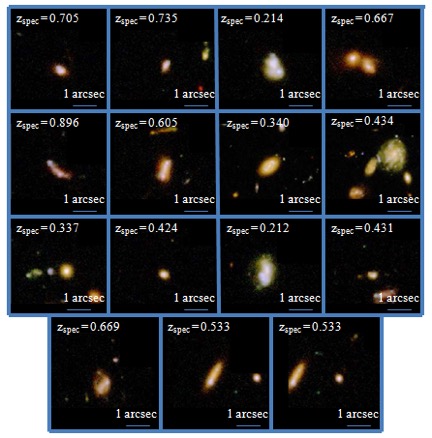On the formation redshift and cosmic role of dwarf galaxies: low-mass star-forming galaxies at intermediate redshifts
PI: Jesús Gallego
Background
Dwarfs are the most common galaxies and play a significant role in galaxy evolution. However, they are objects still poorly understood. Although most of these systems present an old stellar population, disagreements remain about the period of their dominant star-formation activity.
The environment of low mass galaxies also play a key role and for the first time is already available via the spectroscopic surveys of massive galaxies. Recent results show that low mass galaxies tend to prefer the outskirts of the filamentary structures of the cosmic web, a vorticity rich region where gas fueling may be more efficient allowing to maintain high SF activity. On the other hand in massive halos such as groups and clusters, low mass satellite galaxies are found to be quickly quenched and cease early their star formation.

Figure.- Color composite resulting from the HST images at different bands for an example of low-mass star-forming galaxies at low to intermediate redshifts. Low redshift objects have been introduced for comparison purposes.
Objective
Our objective is to investigate the dwarf galaxy population in building and acquiring samples of star-forming systems selected by mass. This selection implies to select from a catalog including a lot of information, including multiband photometry, photometric redshifts and stellar masses. We have selected 3D-HST as our reference catalog. It provides all info needed for selection for the classic cosmological fields. GOYA should consider one North field and one equatorial field.
Proposal
We propose a new approach in the near-infrared. It will shed some light on the early stellar mass assembly of dwarfs up to z=2 (where stellar populations are several Gyr less evolved). GTC/EMIR deep spectroscopy will provide Halpha and [NII]6548,6584 emission line fluxes and equivalent widths that will help us to characterise the strength of the current star formation process and gas-phase metallicity. We will then combine the emission-line fluxes and equivalent widths with ancillary data to apply an specific code to infer the star-formation histories from emission lines and spectral energy distribution fittings. This study will provide information about the stellar mass assembly of the sample and the corresponding redshift of formation for the targets, whichare observational constraints to current galaxy evolution models. Finally, to better know the cosmic web properties, this proposal is the first opportunity to extend previous analysis in the dwarf mass regime (7<logM<9) and identify their preferred locations with respect to the cosmic web environment (nodes, filaments and voids).